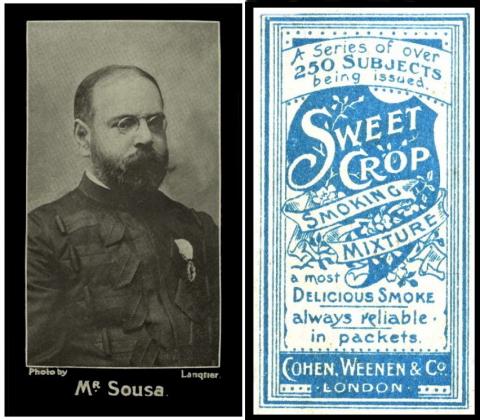
Here we have John Philip Sousa, born in 1854, and known as The March King, but nothing to do with the month, this referred to his music, and specifically the kind of stimulating regular tunes that a group could march to. Some of his best known marches are "The Stars and Stripes Forever" and "Semper Fi" (actually Semper Fidelis, and this is the official march of the U.S. Marine Corps as well as the National March of the United States of America. He would be proud of the fact that the Marines still use it, for he started his career in the United States Marine Band,
He was a proficient musician on many instruments, and also helped to invent one, the Sousaphone. By Saturday we will have found one of these on cards, but it is proving elusive tonight!
Added March 15th, 2023 : Since writing this post we have found out something rather amazing, and that is that in 1925 the company of P. Lorillard advertised a cigar called "The March King", which retailed for the price of three cents each (five for 15c). In these adverts could plainly be seen the face of the actual March King, John Philip Sousa, sometimes contemplating the cigar and sometimes actually smoking one. His face also appeared on the label of every cigar.
However Lorillard had not asked his permission first, so in May 1925 Sousa sued them, took them to the Supreme Court no less, and asked for $100,000. His case rested on the facts that they had trespassed on his name, made him the butt of jokes amongst his friends and future employers. Worst of all they had insulted him by attaching his name to a cheap cigar when it was common knowledge that his favoured brand was Fonseca`s "McKinleys", named after the President, and specially imported from Havana.
In the end the matter was settled out of court, and the cigar was removed from sale.
H. Cohen, Weenen, & Co. was one of the smaller tobacco companies, and were established in 1864, in Brown`s Lane, in Spitalfields, East London. They stayed quite small, hoping to gain a niche market rather than fight against the might of the larger companies.
One thing we have uncovered is that on the 24th of February 1869 the partnership between Henry and Solomon Cohen, and Alfred Weenen, Importers and Manufacturers of Cigars, was dissolved. More excitingly, Solomon Cohen did not sign his name to this document, but made a mark, signing with a cross.
The gist of the matter was that the Cohens were going to continue with a company called H & S Cohen, but Alfred Weenen was not coming along. All the documents state this to have been by mutual consent, though it does say one strange thing, that being that "all debts due.to and owing by the said late copartnership will be received and paid by the said Henry Cohen and Solomon Cohen". So maybe Mr. Weenen had exceeded his means one too many times?
Despite this, the name on the cards and the tobacco remained the same, Cohen Weenen, from 1891-1923.
Then in 1927, they became a limited company, but were taken over four years later by Godfrey Phillips. Whether this had anything to do with a lawsuit in America over some tobacco that had been damaged in the recent storms, is unclear.
Godfrey Phillips were bought out by Phillip Morris in the late 1960s
The main Cohen Weenen brand was "Sweet Crop", through which most of their cards were distributed. Some of their other brands were :
- "Afrikander" (tobacco - 1930s - sold in various styles, including "Colonial Flake" and "Smoking Mixture")
- "Bishops Move"
- "Classic Curly Cut" (tobacco)
- "Dames" (cigarettes -1890s),
- "Gaiety Girl",
Our original World Tobacco Issues Index describes this set as
Celebrities - black and white (A) sm. 67 x 36. Un`nd (65) See H.88
(A) "over 250" back
(B) "over 500" back
The (A) means that the set is actually untitled, but was given the title of Celebrities by early researchers. You will note that the (A) follows the "black and white" - this is because there were two sets that were given this name but the other one showed the subjects in colour.
An almost identical description appears in our updated World Tobacco Issues Index, except that it adds the fact that all sixty-five cards are known in set (A), whereas only nineteen are known with the "over 500" back. All the subjects are listed in the handbook under H.88, but I have been unable to find out which of them appeared on the "over 500"s and formed the nineteen. If anyone out there has a card like this with an "over 500" back maybe you could let us know the title on the front and we will start a list....
